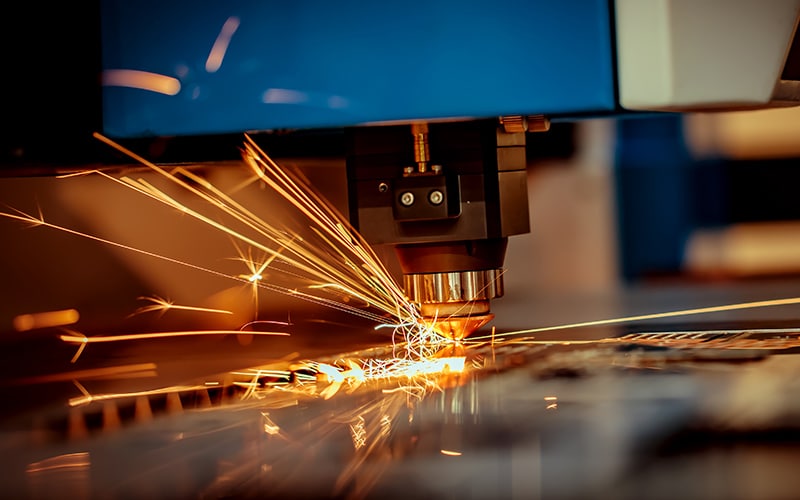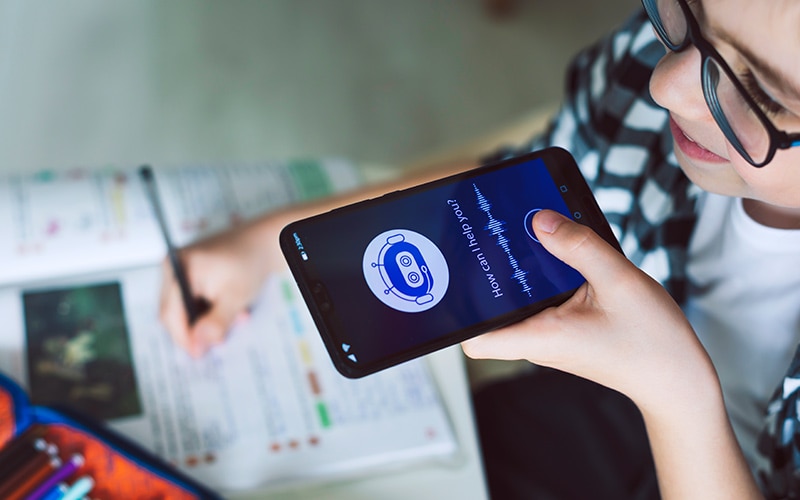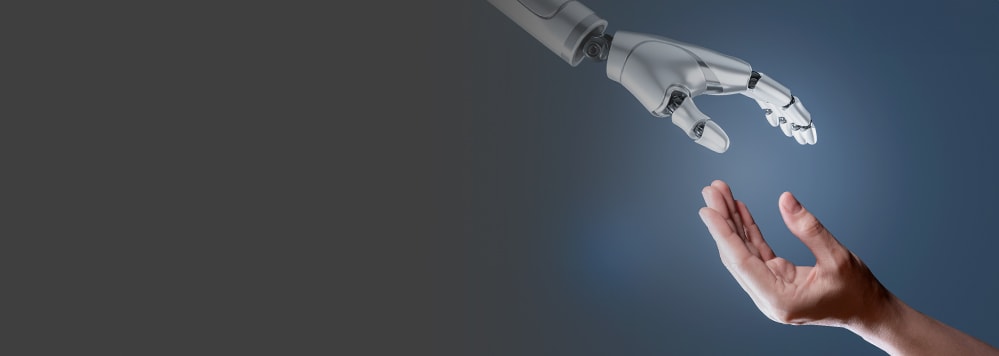
Insights
- Many tasks and processes will no longer be performed by humans, and will be performed faster with higher quality by AI.
- Humans will play less of a direct value delivery role and more of a creator and trainer role for the AI systems increasingly engaged directly in value delivery.
- However, AI technologies, while powerful and capable, will need to rely on human involvement to function optimally and deliver meaningful results.
- Organizations have to consider this while choosing what work AI will do.

The explosive growth of AI is driving a transformation across organizations. In an AI-first operating model, humans will step into new roles as designers and overseers of the automated, algorithm-driven AI systems that are increasingly delivering services, freeing the humans up to do more satisfying, less mundane work. Customer service representatives in retail now spend less time on routine inquiries, which are handled by AI chatbots, and more time on complex problem-solving and managing customer relationships. In healthcare, AI technologies are being used to tackle caller inquiries and for appointment scheduling, as well as more advanced tasks such as producing cancer screening reports more quickly.
There have also been changes in the roles of leaders. Traditional management practices such as supervision – especially of employees performing standard tasks – are becoming obsolete in some fields such as manufacturing, finance, and logistics. In the AI-powered operating model, managers are increasingly becoming innovators, designers, and integrators. For instance, they design by shaping, controlling, and improving the AI systems that sense and respond to customer needs more efficiently and at a greater scale than humans can achieve. Leaders also function as guardians by ensuring the reliability, quality, security, and ethical decision-making of the AI systems they oversee.
In the AI-powered operating model, managers are increasingly becoming innovators, designers, and integrators .

Significance of the human-AI collaboration
Why does this matter? What’s the positive impact of humans handing off some direct value delivery to AI, and instead doing more design, innovation, guidance, and guardianship of those AI systems? The answer is, this shift can transform the organization's growth potential by removing human operating bottlenecks that constrain its scale and scope. It offers a competitive edge for businesses that are quick to adopt it, functioning as an innovation catalyst.
On the organizational side, it fosters cross-disciplinary collaboration and drives cultural transformation. When AI is used for revenue growth management in organizations, it requires teams across departments – be it sales, marketing, or product teams – to coordinate and exchange the right information with each other that can go into feeding the AI to develop a holistic organizational strategy. It promotes an agile culture and product-centric value delivery (PCVD) mindset marked by teamwork, continuous feedback, and improvement. On the people side, it empowers employees and develops their ability to adapt and learn.
-
Automation and efficiency
The ability to automate repetitive tasks consistently shows up as one of the most noticeable impacts of AI in the workplace. For instance, Infosys helped a US-based medical equipment manufacturer implement an AI assistant for customer service delivery. It helped detect the intent of conversation and caller emotion in real time, recommend suitable responses for agents, and analyze call transcripts saving time and effort. In a related case, Infosys helped a US-based pet food manufacturer implement generative AI for content creation and personalization at scale for marketing materials. Infosys also helped a Korean automotive manufacturer implement generative AI to improve the search experience for users looking up information in maintenance and technical documents, warranty and recalls, product literature and customer invoices, which optimized their time and effort.
Porsche Engineering provides another example of using AI for automation and efficiency. Porsche uses AI to gauge the aging behavior of lithium-ion batteries in their cars and predict the remaining range of the electric vehicle allowing human workers to take on roles like overseeing operations, troubleshooting complex issues, and developing new processes.
-
Decision support and insights
AI's capability to analyze data in real time means that human workers are freed up to take on the important role of interpreting AI-powered insights, understanding the broader implications, and strategizing accordingly. This requires a blend of domain expertise, creativity, and interpersonal skills – areas where human intelligence excels over AI. For example, by identifying trends in disease progression, AI can predict possible complications, allowing healthcare professionals to develop preventive strategies. -
Personalization and customer experience
In customer-facing roles, chatbots powered by natural language processing (NLP) can handle customer inquiries, provide personalized recommendations, and even resolve complaints. Brands such as Sephora and Zara are using AI chatbots to make product recommendations to customers. AI innovations have helped Sephora increase its e-commerce sales in the past few years. Estee Lauder has introduced a mobile app that combines AR and AI to help visually impaired individuals apply makeup. Personalization fosters stronger customer relationships, improves overall satisfaction, and increases revenue for brands. AI tools can also analyze customer behavior patterns to predict preferences and tailor marketing campaigns accordingly. Netflix uses AI to study user reviews and perform sentiment analysis to make viewing recommendations for its users, and tailor its promotional campaigns.
Humans are critical in this equation
One area that shows how humans working with AI can produce better outcomes is healthcare: here, AI can sift through large volumes of information to get suggestions on treatments, but human medical professionals provide the essential skills of interpreting these suggestions, considering patient-specific factors, and critically, making final treatment decisions.
On the organizational side, AI promotes an agile culture and product-centric value delivery (PCVD) mindset marked by teamwork, continuous feedback, and improvement.
In the consumer packaged goods (CPG) sector, AI can help businesses right-price their products provided humans keep an eye on whether the AI tools are digesting relevant and high-quality data to produce insights. Such human-AI partnerships show AI's data processing capabilities are complemented by human creativity and ethical considerations.
People can accelerate AI and create new jobs. But there are challenges to overcome:
-
Skills gap: As AI and automation change the nature of work, there is a growing skills gap. Individuals need to acquire new skills to stay relevant in an AI-driven job market. This need for upskilling and reskilling presents a significant challenge for both employees and employers. Workers must be willing to learn and adapt, while companies must invest in training programs to equip their workforce with the necessary skills. Of the businesses surveyed for Infosys Knowledge Institute’s Generative AI Radar 2023 North America study, 33% cited partnering with vendors to leverage their skills and talent as their plan to close the skills gap issue.
As AI and automation change the nature of work, there is a growing skills gap.
- Ethical considerations: While AI offers numerous benefits, it also raises ethical considerations regarding privacy, job displacement, and biases in decision-making algorithms. Companies must steer through these challenges responsibly, ensuring that AI technologies are deployed ethically and transparently.
- Concern over negative impact on jobs: According to the Global Public Opinion on AI (GPO-AI), 2024, individuals globally are very concerned about the impact of AI on jobs, privacy violations, and the dehumanization of services. Companies using AI must understand that people worry about job losses. Also, the impact on people framework will differ by country. Consider, for example, the high level of legal worker protections in Germany and Sweden compared to the United States. Firms must factor these concerns into the generative AI shift by emphasizing transparency, ethical AI practices, and continuous dialogue with stakeholders.
People and organizations control their own destiny
To create the optimal, mutually beneficial, human-AI partnership, organizations must combine the best of what each side uniquely provides. Humans bring creative, high-order strategic thinking, while AI excels at intensive data processing, number crunching, and automation. To unite the two and successfully navigate the radical change, organizations must embrace the three Rs: reassess, rebalance, and reskill.
-
Reassess: Organizations must understand the impact of AI on their people. They must determine the impact of AI on roles, other systems, and the interplay between humans and AI. Will humans be able to adequately run the AI systems? Will the AI system's needs be met by its human partners making the best possible use of what it has to offer? This assessment should consider key people-related change topics such as governance, prioritization, resource allocation, innovation, and ROI. When a high-growth software company embarked on AI and automation with limited central oversight, an unintended side-effect emerged: the proliferation of disparate tools across teams, with little collaboration or shared benefits. Empathizing with the company's struggle to manage its rapid growth while harnessing new technologies, the Infosys AI and Automation and Workforce Transformation teams stepped in. They conducted a top-down analysis and identified teams with high automation potential based on headcount, geography, and nature of work. Recognizing the importance of knowledge sharing, Infosys educated and guided key client stakeholders on AI and automation. They crafted business cases outlining the client's multi-year investment, potential value, and operational approach. This helped the client consolidate tools and implement automations to reduce costs as the company scaled.
-
Rebalance: Organizations need to reallocate work between humans and AI systems. Assign humans the tasks they do best and let AI handle what it excels at. They will also need to integrate continuous learning and ongoing education for both leaders and individual contributors, as the answers to AI questions will change as AI offerings evolve.

-
Reskill: Organizations will need to reskill employees with the new abilities they need to support AI systems. They should upskill and hire for both soft and technical skills, with a particular emphasis on techno-functional skills—technical expertise combined with deep business knowledge. This will be crucial for designing, guiding, and integrating AI systems effectively. Additionally, they need to build AI systems that can constantly learn. This is inherent in many AI systems today but bears repeating, especially for leaders who have spent millions upgrading or replacing legacy systems and upscaling the workforce. The sea change induced by AI and generative AI is not just about adopting new technologies, it's about fundamentally rethinking how work is done and how value is delivered.
The sea change induced by AI and generative AI is not just about adopting new technologies, it's about fundamentally rethinking how work is done and how value is delivered.
Consider, for instance, how when a German utilities company ran into the challenge of how to make the most of generative AI without stifling innovation. They initiated a partnership with Infosys, who guided them through a paradigm shift. They established a generative AI center of excellence (CoE) and built a governance framework that balanced control and creativity. The CoE streamlined processes and improved the governance, training, and operations. This focused on a cultural shift, helping to remove blockers and transform potential resistance into adoption.
By understanding and facilitating the partnership between their human employees and the right AI tools, organizations can unlock new growth potential, foster innovation, and ensure ethical AI usage. AI is not so much replacing humans in the workplace as it is redefining the roles they play. Organizations that understand this and make the most both of AI and of their employees will be the ones that succeed.




